Varietal features of the Antonovka apple tree
Popular fruit crops adorn gardens and small plots of land. The Antonovka apple tree is an old species, the exact origin of which is unknown. It is used to create resistant hybrids. Trees of the variety grow on any soil and are undemanding to care for.
- Benefit and harm
- Advantages and disadvantages
- Varieties
- Characteristic
- Description of the tree
- Description of fruits
- Growing region
- Disembarkation
- Timing
- Technology
- Care
- Irrigation works
- Fertilization
- Pruning and shaping the crown
- Preventive work
- Grafting culture
- Features of ripening and fruiting
- Harvesting and storage
- Popular subspecies
- Gardeners reviews
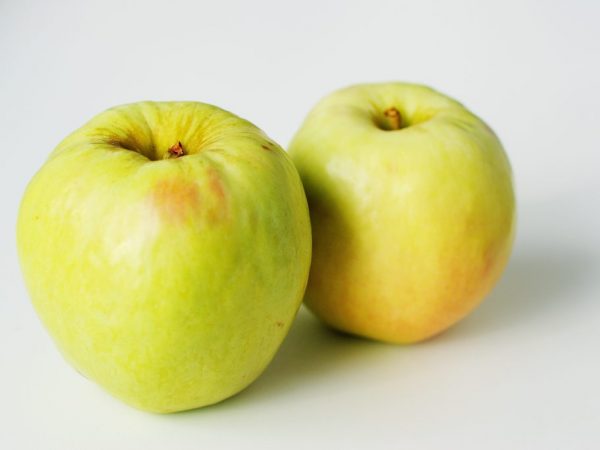
Varietal features of the Antonovka apple tree
Benefit and harm
The Antonovka variety is known all over the world. Its tasty fruits, juice, processed pulp are used in dietary nutrition. Fruits are useful for adults and children. The following properties of Antonovka determine its popularity:
- the content of vitamin C, which helps to strengthen human immunity;
- a large amount of B vitamins;
- the pulp contains iron, potassium and calcium - components necessary for the body.
The benefits of the variety appear immediately: if you eat fragrant pulp regularly, you can strengthen the body, protect yourself from seasonal diseases and viral infections.
The fruits of white, red Antonovka and apple trees on any rootstocks are useful. Fewer calories are the main benefit of a fresh product. Baked apples are tasty and healthy: they can be consumed even by pregnant and lactating mothers.
In addition to the benefits, the species has contraindications. Fruits are harmful if consumed on an empty stomach or during an exacerbation of chronic gastrointestinal diseases. In addition to such negative reactions, excessive consumption of a fresh product affects the state of the enamel.
Also, you can not eat more than 5 seeds per day, so as not to oversaturate the body with hydrocyanic acid.
Advantages and disadvantages
A flowering tree graces the garden - this variety stands out from other horticultural crops. This is a tall apple tree with a lush crown and beautiful inflorescences. The flowering of the variety is moderate, so the tree is grown for decorative purposes.
In addition, the advantages of the variety include the following characteristics:
- frost resistance - it can be planted in a region with any climate: if it is too cold in winter, the tree is insulated. Freezing occurs rarely, and by spring all the branches are restored;
- the variety has several related subspecies - these include White filling, or Papirovka;
- choose Antonovka for its delicious apples and stamina during growth in all regions of Russia;
- the variety is universal. It is used raw or processed. Delicious juices, mashed potatoes, compotes are obtained from the fruits. Their taste is sweet but not cloying - another advantage of the species;
- use wood for the stock. It strengthens any other garden culture. Antonovka prolongs the ripening period of fruits, but increases their number. Thanks to the stock, the resulting hybrid does not suffer from frost;
- vigor is the advantage of the variety. The tree develops quickly and creates the right shade for other crops;
- the culture does not suffer from strong winds or excessive rainfall;
- the garden in which Antonovka grows is never empty in the cold season: the tree is frost and drought resistant;
- it has good compatibility with other hybrids;
- has good transportability;
- shedding of fruits from the branches is rare, and in most cases the gardener himself controls this process.
The species also has disadvantages - if necessary, they are leveled by proper care. The first fruits can be seen late on the branches. For the first 5-6 years, no ovaries, inflorescences, or fruits can be expected from the tree.
The immunity of the variety is good, but only to certain types of diseases. To reduce the risk, choose the right land for planting a seedling.
Antonovka suffers from the moth. If you do not protect against parasites, the tree grows poorly, and during the year leaves fall, branches grow crooked. It is impossible to allow the reproduction of parasites, because the entire future harvest depends on the state of the trunk.
Periodic fruiting is also considered a disadvantage of the species. The warmer the region where the culture grows, the more it looks like an autumn variety in its properties and fruiting period.
Varieties

All species need the same care
Antonovka is a variety type. It includes several similar varieties. Most of the apples that are grown on trees on an industrial scale are of this species. These varieties of apple trees are cultivated on the territory of Russia:
- ordinary. Autumn and early winter variety. The exact ripening period depends on the climatic conditions. She has a strong crown that needs to be formed every year. Fruit color is yellow-green, blush often appears. The sugar content in apples is more than 9%;
- dessert. Isaev became the creator of the hybrid. Average winter grade. The tree is medium-sized. The shape of the crown is round. The fruit is dark green. The blush appears closer to ripening. The yield of one tree is 120 kg. High tasting score;
- gold. A hybrid that bears fruit towards the end of summer. The best territory with a suitable climate for planting crops is Crimea. Fruits are medium to large in size. The weight of one apple is 170-200 g. The taste is sweet and sour.
Subspecies need similar care. The size of the tree is regulated with the help of rootstocks, which are used to improve the characteristics of Antonovka.
Characteristic
Initially, the variety has the characteristics of a wild-growing apple tree. Antonovka's lifespan is up to 40 years, subject to all agrotechnical requirements. She has stable flowering and fruiting. If you graft a variety on another crop, it bears fruit longer and more.
The key to a tree's long life is its root system. Provides strong roots with stable fruiting. The ripening of fruits also depends on the root system: their quality is regulated by the stock and the main type of seedling. The depth of the rhizome is at least 70 cm.
Yield description: from one mature tree, you can harvest up to 200 kg of apples. In this regard, the golden Antonovka is the most productive, and up to 500 kg are harvested from one such tree per year. Belaya Antonovka is less productive - up to 250 kg of apples are harvested from it.
Resistance to common garden diseases is average. If an epidemic of scab begins, Antonovka apple trees may lose all leaves and fruits. To prevent such negative changes, regular prophylaxis is carried out.
Description of the tree
The description of the tree directly depends on the rootstock - this is the main factor that determines the height of the apple tree and the thickening of the crown. The average height of a tree is 6 m. Due to the popularity of "dwarfs" on such a rootstock, the culture grows up to 3-4 m.
The crown is powerful with thick, sturdy branches. The culture does not need to be propped up. A tree grows from a weak planting material: the seedlings have a thin trunk and a small, not yet grown, root system.
Flowering Antonovka occurs only in the presence of the right neighborhood - cross-pollinators can increase the number and quality of fruits. Belaya Antonovka needs pollinators that grow no further than 50 m away from it. Anise or Welsey apple trees are a good option for cross-pollination.
Description of fruits
Antonovka apples are green. The closer the ripening period of the crop, the more the basic shade changes - the fruits turn yellow, and a characteristic blush is visible on the sides. Only the golden Antonovka does not get this color, and the fruits are yellow until the time of harvest. Thanks to the beautiful appearance of apples, the garden is transformed.
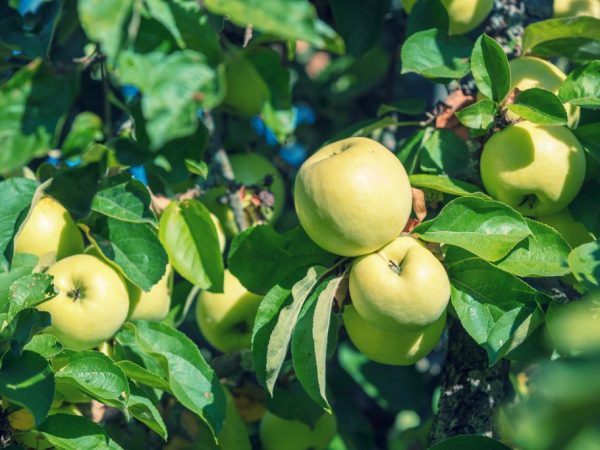
The fruit tastes good
Average indicators of the variety, which received all types and subspecies:
- the weight of one fruit ranges from 150 to 300 g, a half-pound fruit can weigh up to 600 g;
- the rind is moderately thin, but dense;
- the taste is saturated sweet and sour - if the fruits are harvested ahead of time, their pulp is sour and tart;
- the pulp is firm, but tender, its color is white or cream;
- dessert Antonovka has a tasting rating of up to 4.5 points;
- the aroma is strong and spicy.
The taste of apples is complemented by their beneficial properties. 100 g of fresh product contains only 49 kcal. This calorie content is used to create a balanced diet. The apple looks attractive, so it is often put up for sale. White Antonovka does not suffer from long-term transportation, and golden Antonovka begins to thin out a pleasant spicy aroma.
The taste of all subspecies is excellent - the tasting score is never lower than 4 points.
You can remove the fruits in the middle of autumn and before winter. They do not lose their taste or appearance. The Antonovka apple variety is kept fresh at home or processed.
Growing region
Since 1947, the culture has been regionalized throughout Russia. In the northwest, the variety has taken root in the Leningrad and Ryazan regions. The tree grows rapidly in the Moscow region and does not suffer from early frosts. All types of Antonovka are cultivated in the central regions.
Moderate frosts and droughts, clear transitions between seasons create suitable conditions for the crop. In the Vitebsk region (Belarus), Belaya Antonovka has taken root well - it is also called Mogilev. The onion subspecies also grows on the territory of Belarus.
Disembarkation
To properly plant any subspecies of the variety, you must:
- prepare a land plot - the quality of the soil is not important to the culture, but the more fertile the soil, the faster the rhizome takes root, and the roots provide a stable and large harvest;
- to plant an apple tree in open ground, planting material is prepared - this is a 2-year-old seedling, the height of which is not less than 1.5 m;
- preparing a planting pit - it will be a source of nutrition for the seedling.
Immediately after planting, the seedling is provided with shelter and care is established. By the 6th year, apples will appear on the branches, the number of which will grow every year.
Timing
Like any other fruit tree, the variety is planted in spring or fall. Pick up a warm day when there is no precipitation or freezing of the soil. If work takes place in the spring, you need to check the condition of the soil. A layer heated to 10 cm is suitable for further planting.
After that, gardeners monitor the processes on adult trees: you must not miss the moment of the appearance of ovaries - after that, planting cannot be carried out.
Autumn planting follows the same pattern. They check the quality of the soil - for this, the entire land plot is removed. First, the gardener takes the crop, and only then does other work. Autumn planting is combined with the preparation of fruit crops for winter. The seedling is covered and protected from rodents with special nets.
If the planting takes place in the spring, the pit is prepared in the fall - this approach will allow the gardener to properly plant the seedling.
Technology
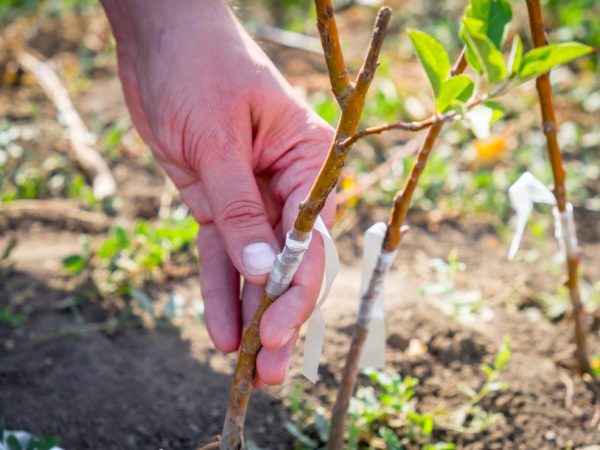
The seedling needs feeding
Landing differs in terms of pit preparation. If for a standard scheme such a period takes no more than 2 weeks, then for Antonovka it takes at least a month.Fertilizers are preliminarily applied to the created hole - this is the main condition for the germination of the root system. Use mixtures, settled humus or compost.
When choosing a land plot, loamy soil is preferable: it requires less fertilizers. A layer of organic matter is introduced at least 3 cm.The height of the groundwater should not exceed 3 m.
The disembarkation takes place in this order:
- create a pit. The distance between crops should be at least 3.5 m. A pit is created with a depth and diameter of 1 m;
- when it "stands", dig up its top layer;
- a seedling is placed in it - a two-year-old material takes root better. Its roots are leveled;
- the seedling is covered with fresh soil, and a roller is made around the trunk;
- the tree is watered.
At first, the seedling receives nutrients from the planting pit. Regular care is established within a month.
Care
There are winter and summer treatments. These are two different systems. They take into account the state of the tree and its internal processes. Crop care includes constant weeding of the land. Any extraneous plants draw moisture from the rhizome.
Loosening the soil will help improve routine maintenance. The harder the soil layer, the harder it is for the rhizome to get moisture. Loosening increases the throughput of the soil.
Obligatory care includes watering, feeding and pruning, supplementing it with prevention. All the energy spent by the gardener pays off with a delicious harvest. Winter care is minimal: watering and feeding are not carried out. For the winter, the tree is covered and protected from low temperatures.
Irrigation works
Watering is carried out in two stages - the liquid is introduced, and after that it is checked to what depth it has been absorbed. In this case, the amount of water is not the main indicator. Proper care assumes that watering will not increase either during drought or during the cold season. The optimal depth of regular watering is at least 15 cm.
Watering Antonovka is carried out in this way:
- the first irrigation coincides with the beginning of flowering - it is better to water the apple tree a week before the ovaries begin to bloom;
- second watering - when apples are formed;
- third irrigation - 2 weeks before harvest;
- the next time the apple tree is watered after harvest;
- the last (fifth) watering occurs after the tree is left without foliage.
In summer, extra watering is carried out as the soil layer dries up. While the tree is in bloom, it is best not to water it. The best watering method is drip. It is used throughout the year. During the period when the apple tree is sick, the culture is not watered. Such actions will only aggravate the situation.
Fertilization
Care includes fertilizing the soil, but not too often - in the first year the tree must adapt, otherwise it will not grow. The first feeding is carried out in the second year. For this, slurry is used.
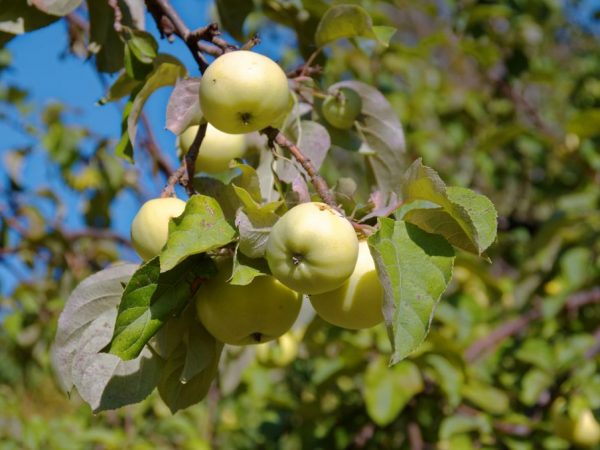
Fertilizers increase the yield of the tree
Organic matter is dissolved in water in a ratio of 1: 5. With the help of the liquid, the concentration of active substances is reduced. Leave the mixture for 5 days to ferment it, and only then add it to the root of the tree. After feeding, the soil is loosened.
The next time the tree is fertilized is in May. Liquid fertilizers are used. The added recharge will allow the buds to form faster. Fruiting time is a good time to fertilize. Use at least 50 g of superphosphate per tree. Phosphorus has a beneficial effect on the apple tree, but only before the beginning of fruiting.
Spraying, as a fertilization method, is carried out during the period of active growth of the tree. Foliar dressing is useful for the trunk, leaves, and only then for the roots. Use nitrogen, a mixture of phosphorus with potassium. Foliar fertilization is combined with irrigation.
Pruning and shaping the crown
Antonovka needs frequent pruning. It is better to carry out the procedure twice a year - in the spring and autumn periods. After winter, all processes inside the trunk have not yet recovered, and closer to winter they slow down again. During this period, the risk of harming the apple tree is minimal.
Gardeners carry out the first procedure from the second year. Every third branch is removed from the trunk. Such procedures will help increase fruiting.
In the fall, sanitary pruning is carried out for the apple tree. In order for the Antonovka apple tree to have the opportunity to survive the winter, old, sluggish and diseased branches are removed - they will not draw moisture from the trunk. Garden pitch is used to treat the places of the cuts so that pests do not start.
Immediately after that, the culture is prepared for winter. Mulching is carried out. A covering of hay, grass and peat will protect the apple tree from a sharp cold snap.
With the help of pruning, a tiered, fusiform and columnar crown shape is formed. Regular branch removal ensures the rejuvenation of the culture - new shoots grow in spring, on which new fruits are formed a year later. Pruning is a guarantee of a long life for the culture.
Preventive work
Delicious apples only form on a mature and healthy tree. To strengthen the culture, they carry out prevention. If the apple tree is sick, it must be treated immediately. Sick branches are removed, and the soil layer is dug up.
For prevention, fungicides are used. They enhance the natural defenses of the crop. Before planting, the roots of the seedling are soaked in Fitosporin solution. A purchased product enhances the immunity of the planting material.
Grafting culture
Various types of Antonovka are vaccinated. To do this, use one of the popular methods:
- with a handle. The simplest and most common method. Cuttings with 2-3 buds are used. Inoculate only the strengthened material. If there are traces of rot or the stalk is weak, it is dangerous to use it;
- copulation. The method is divided into two types - simple and improved. For small land plots, a simplified vaccination scheme is chosen;
- using the bark. This method is also called "bark". Vaccination takes place in the warm season and only with matured processed material;
- with an eye. The procedure is carried out in spring and summer. In the cold season, the vaccine will not take root. Budding occurs through the kidney or scutellum.
Clean garden tools are prepared for inoculation so as not to infect the tree with an infection. The most convenient is the secateurs, which will allow you to carry out the procedure in half an hour.
Features of ripening and fruiting
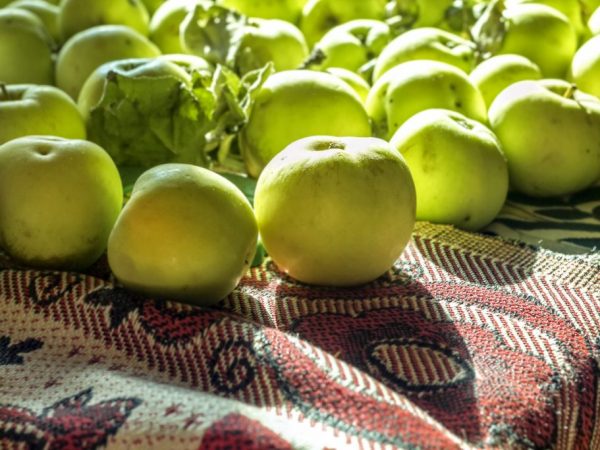
The first fruits can be obtained in five years.
The Antonovka ordinary apple tree has a late ripening period: it will be possible to get a harvest only for 6-8 years. The timing is partially influenced by care - watering and fertilizing the soil. But earlier than in the 5th year, the culture will not bloom. At home, you can graft a culture: clones bear fruit earlier.
The flowering of the variety is medium late. It lasts no more than a month. Fruits ripen at different times depending on climatic conditions. The tree bears fruit from late summer to late September. Stable fruiting does not occur until the 10th year.
Harvesting and storage
The ordinary Antonovka has tasty and fragrant fruits. They are easy to transport. Storage of apples will not create problems either. If you pick apples in September, it is better to immediately place them in constant conditions.
Fruit storage takes place with a certain temperature regime. Apples will "stand" all winter and will not deteriorate if the room is not warmer than 2-4 ° C. Fruits are stored for up to 90-120 days.
Popular subspecies
The tree survives a frosty winter and bears fruit stably - such conditions persist if you choose the right stock on which to grow the tree. Popular subspecies of the Antonovka apple tree:
- on a dwarf rootstock. The yield is up to 120 kg per tree. The first fruits are formed in the 8th year;
- on a semi-dwarf rootstock. The first fruiting occurs at 4-5 years. The height of the tree is no more than 3 m;
- one and a half pounds. The apple tree, six hundred grams in fruit, grows in the southern regions. Partially self-fertile;
- columnar. The rarest variety. Apples are difficult to pick and grow. For small plots of land, the method is too expensive.
Gardeners reviews
The ordinary Antonovka and any of its other subspecies have many admirers.Gardeners love the variety - it has tasty fruits and high yields. The disadvantages include the late appearance of the first harvest. You can expect fruits from Antonovka not earlier than in 6 years.
Medium-term storage of fruits, but they are healthy and very tasty. At home, the variety can be used to inoculate other fruit trees.

